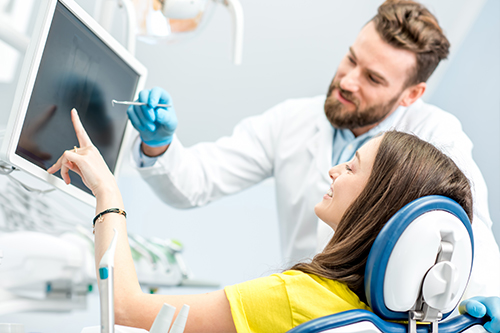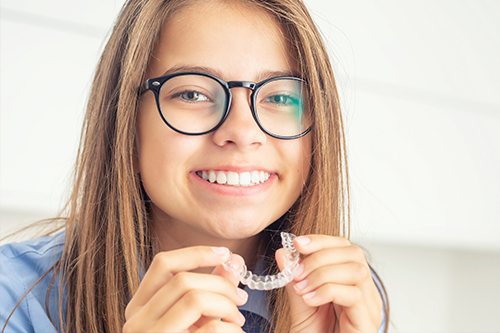Schedule a focused evaluation
Your initial visit allows the clinician to examine your bite, review digital records, and outline how aligner therapy could address your concerns.

Invisalign® clear aligners offer a discreet, science-driven way to reshape a smile without interrupting everyday life. Using a series of nearly invisible trays, modern aligner therapy moves teeth in small, predictable steps while preserving the convenience of removable appliances. Many patients choose this approach for its combination of subtlety, comfort, and the precise control it offers to clinicians.
Invisible aligners are designed to be low-profile and comfortable. Constructed from smooth, transparent thermoplastic, each tray fits snugly over your teeth and offers a more aesthetic alternative to visible metal brackets and wires. Because the aligners are removable, patients can maintain their usual oral hygiene routines and enjoy meals without the dietary restrictions commonly associated with traditional braces.
The discreet nature of aligners makes them appealing to adults and image-conscious teens who want orthodontic progress without drawing attention. In addition to cosmetics, aligner therapy focuses on efficient tooth movement—often prescribing each tray to be worn for about one to two weeks to guide teeth incrementally toward the planned result.
Beyond looks, many patients notice practical benefits: fewer emergency visits for broken wires or brackets, easy brushing and flossing between stages, and aligners that generally require minimal adjustments from the clinician while still delivering predictable movement when worn as directed.
Modern aligner systems begin with a detailed digital assessment rather than traditional impressions. A precise intraoral scan or 3-D imaging captures the current position of your teeth and bite, creating a virtual model that clinicians use to visualize every step of the proposed movement. This digital workflow allows both doctor and patient to preview the projected progression of the smile before any trays are fabricated.
From the scan, a customized sequence of aligners is produced to advance teeth along a carefully mapped path. The clinician reviews and refines this plan, making adjustments where necessary to account for individual anatomy, tooth-root position, and the types of movement required. This level of planning helps reduce surprises and supports a smoother course of treatment.
Where additional support is needed—such as attachments (small tooth-colored bumps) or controlled interproximal reduction (minor enamel adjustments)—these elements are incorporated into the plan to enhance effectiveness. The combination of digital planning and clinician oversight helps translate the virtual treatment plan into real-world results.
Success with clear aligners depends largely on consistent wear. Most treatment plans call for aligners to be worn around the clock, removed only for eating, drinking (other than water), and oral hygiene. Adhering to the prescribed wear schedule ensures the programmed tooth movements occur on time and that treatment stays on track.
Caring for aligners is straightforward: rinse them after removal, brush them gently with a soft brush, and avoid hot water that could warp their shape. Maintaining diligent brushing and flossing is easier with removable appliances, which helps reduce plaque buildup and supports overall oral health during treatment.
Follow-up visits are typically scheduled at intervals that allow the clinician to monitor progress, make refinements, and provide the next set of aligners. Patients should expect gradual changes over weeks and months; because teeth move incrementally, subtle progress becomes more apparent as treatment advances toward the predetermined goal.
Clear aligner systems are capable of managing a broad variety of alignment issues, from mild crowding and spacing to many bite irregularities. They are commonly used to correct rotations, tipping, minor extrusion or intrusion, and to close gaps between teeth. For many adults and adolescents, aligners provide an effective path to improved aesthetics and function.
That said, certain complex orthodontic problems—severe skeletal discrepancies or extremely intricate tooth movements—may require complementary techniques or alternative appliances. During an initial evaluation, the clinician assesses whether aligner therapy alone is appropriate or whether adjunctive measures (such as temporary attachments, elastics, or staged hybrid treatment) should be recommended to achieve the desired outcome.
The suitability of aligner treatment is best determined through a clinical exam and diagnostic imaging. Factors such as bite relationship, tooth shape, and periodontal health all influence how a treatment plan is designed and executed. A tailored approach helps ensure that aligners are used where they can reliably deliver predictable results.
Your path toward a straighter smile starts with a focused consultation and a digital scan. During the visit, the clinician will evaluate your teeth, discuss goals, and explain the treatment timeline and workflow in clear terms. This visit is an opportunity to see the proposed plan, understand any recommended adjuncts, and ask questions about day-to-day expectations.
Once your customized plan is finalized, trays are fabricated to match the mapped sequence of tooth movements. The practice will guide you through the initial fit, show you how to insert and remove aligners safely, and outline care instructions to keep both your aligners and teeth healthy. Routine monitoring visits ensure that progress aligns with the digital plan and allow your provider to make minor course corrections if needed.
After the active phase of aligner therapy, an essential retention phase follows to preserve the new tooth positions. Retainers—whether removable or fixed—help maintain the smile over time. Your clinician will recommend a retention strategy that fits your lifestyle and long-term goals, with periodic check-ins to confirm stability.
At Stahl Dental Studio, our approach blends modern aligner technology with careful clinical oversight to help patients pursue effective, discreet orthodontic care. We focus on personalized plans and consistent follow-up so each patient moves toward a healthy, lasting result.
As pioneers in the field of aligner development and technology, the folks at Align Technology, Inc. gather data from millions of treated smiles to design treatment systems that:
Custom-made to the exact specifications of your smile, Invisalign® clear aligners are designed to incrementally move your teeth into their correct positions over time. Simply swap-out last week's aligner for the next one in the series and watch as your smile progressively shows signs of improvement.
And, because Invisalign® clear aligners are removable for short periods of time, you can still enjoy the foods you love as well as brush and floss your teeth with ease!

Your initial visit allows the clinician to examine your bite, review digital records, and outline how aligner therapy could address your concerns.

A fast, precise scan creates the roadmap for treatment and shows a preview of potential improvements so you can make informed choices.

Trays are manufactured to precise specifications for a comfortable fit and are changed in a sequence that guides teeth toward the goal position.

From the first fit to retention, your clinician will monitor progress and provide the guidance needed to keep treatment moving smoothly.
Explore the true stories and journeys of several Invisalign® patients
*Invisalign® is a registered trademark of Align Technology, Inc.
Ready to learn whether Invisalign® is right for your smile? Contact us for more information and to arrange a consultation with our team.
Invisalign® is a modern orthodontic system that uses clear, removable aligners to straighten teeth discreetly. Each set of aligners is custom-made from smooth, BPA-free plastic to fit snugly and guide teeth into position. Because the trays are nearly invisible, many patients prefer Invisalign over visible metal brackets for a more discreet treatment option.
Treatment is planned using advanced digital scanning and 3-D imaging to map tooth movement from the current alignment to the intended result. A sequence of aligners is produced to apply controlled forces so teeth shift incrementally over time. Your dentist reviews and refines the digital plan so the movement sequence matches both functional and cosmetic objectives.
The Invisalign® process begins with a comprehensive consultation and oral exam to determine candidacy and identify any underlying dental issues that must be addressed first. During this visit your dentist takes digital scans or impressions and evaluates bite relationships, periodontal health and restorative needs. These records form the basis of a personalized treatment plan that outlines the expected tooth movements and timeline.
Once the plan is finalized, a series of custom aligners is fabricated and delivered in phases for you to wear at home. Typically you wear each aligner for about one to two weeks before progressing to the next, following your dentist’s instructions. The team at Stahl Dental Studio monitors progress and makes adjustments as needed to keep treatment on track.
Many adults and teens with mild to moderate spacing, crowding or bite issues are good candidates for Invisalign®. Because aligners are removable and nearly invisible, they are especially appealing for patients who want a discreet treatment option. However, severe skeletal discrepancies or very complex tooth movements may require traditional braces or a multidisciplinary approach.
An in-person evaluation is necessary to assess root positions, periodontal health and jaw alignment before confirming candidacy. Your dentist will also consider habits, compliance potential and any restorative or surgical needs that could affect the plan. Appropriate oral hygiene and consistent wear of aligners—generally 20 to 22 hours per day—are essential for predictable outcomes.
Treatment length varies depending on the complexity of the case and patient compliance. Many adults complete active Invisalign® treatment in approximately six to eighteen months, while simpler cases can finish more quickly and more complex cases may require longer care. Your dentist will provide a personalized estimate during the consultation based on the planned movements and clinical findings.
Sticking to the prescribed wear schedule and attending scheduled checkups helps keep treatment on schedule and can reduce unwanted delays. Occasional refinements or additional aligners may be recommended to fine-tune results, and these are integrated into the overall plan as necessary. After active treatment, a retention phase is recommended to stabilize tooth positions and protect the result.
Most patients experience pressure or mild soreness for a few days after switching to a new set of aligners as teeth respond to the prescribed forces. This sensation is generally temporary and often described as less intense than the discomfort associated with adjustments to fixed braces. The aligners are made from smooth plastic designed to reduce soft-tissue irritation compared with brackets and wires.
If you experience persistent pain, sore spots or problems with fit, contact your dental team so adjustments can be made or a replacement aligner provided. Over-the-counter pain relievers and soft foods can help manage brief periods of discomfort during the initial days of a new tray. Proper fit and careful handling of the trays also minimize breakage and the need for unscheduled visits.
Keeping your aligners and teeth clean is critical for oral health during treatment and for achieving predictable results. Rinse aligners whenever you remove them and brush them gently with a soft toothbrush and clear, mild soap to prevent staining and bacterial buildup. Avoid hot water, which can warp the plastic, and store aligners in their protective case when not in use.
Brush and floss thoroughly after meals before reinserting aligners to reduce the risk of cavities and gum inflammation. Regular dental cleanings and periodontal evaluations remain important throughout treatment to monitor overall oral health. Your dental team will provide specific cleaning products or soaking solutions if recommended for your aligners.
Some Invisalign® cases use small tooth-colored attachments bonded to teeth to help the aligner apply more precise forces for specific movements. Interproximal reduction (IPR) and clear or elastic auxiliaries may also be used when spaces, rotations or bite corrections require additional control. These adjunctive procedures are routine, minimally invasive and are planned in advance as part of the digital treatment design.
Your dentist will explain any attachments or auxiliary techniques during the case presentation so you know what to expect at placement and during wear. Attachments are discreet and blend with the tooth surface, and they generally do not change your cleaning routine beyond normal care. If auxiliaries such as elastics are required, the office will provide detailed instructions on wear time and handling to achieve the intended results.
Invisalign® treatment typically requires periodic in-office visits to monitor progress and receive new aligner sets. Initially visits may be scheduled every four to eight weeks depending on the clinical situation and the practice’s protocol. During these appointments the dentist evaluates fit, checks tooth movement and addresses any concerns or refinements.
Emergency or unscheduled visits are available if an aligner breaks, an attachment loosens, or if you experience significant discomfort that needs attention. The dental team will guide you on how to proceed at home while arranging an appointment so treatment continues with minimal interruption. Good communication and adherence to the visit schedule help ensure predictable progress and timely completion of treatment.
Compared with traditional braces, Invisalign® offers clear, removable trays that are less visible and allow easier brushing and eating. Many adults and image-conscious teens appreciate the aesthetic benefit and the ability to maintain normal oral hygiene routines. However, braces still offer certain mechanical advantages for complex tooth movements and severe bite corrections.
The choice between aligners and braces depends on clinical needs, patient preferences and willingness to comply with aligner wear requirements. Your dentist will review the advantages and limitations of each option and recommend the approach that best balances efficiency, predictability and long-term oral health. In some cases, a hybrid approach or combined treatments with fixed appliances may provide the optimal outcome.
Retention is a critical phase after active Invisalign® treatment to maintain tooth positions and prevent relapse. Most patients wear a retainer full-time for a period determined by their dentist and then transition to nighttime wear to preserve results. Options include removable clear retainers and fixed bonded retainers; your dentist will recommend the appliance that best suits your case.
Periodic follow-up visits help assess the stability of your smile and the condition of any retainers so issues can be addressed early. The team at Stahl Dental Studio provides tailored retention plans and ongoing monitoring to protect the long-term success of your treatment. Maintaining excellent oral hygiene and attending routine dental appointments will help your new smile stay healthy and stable for years to come.
